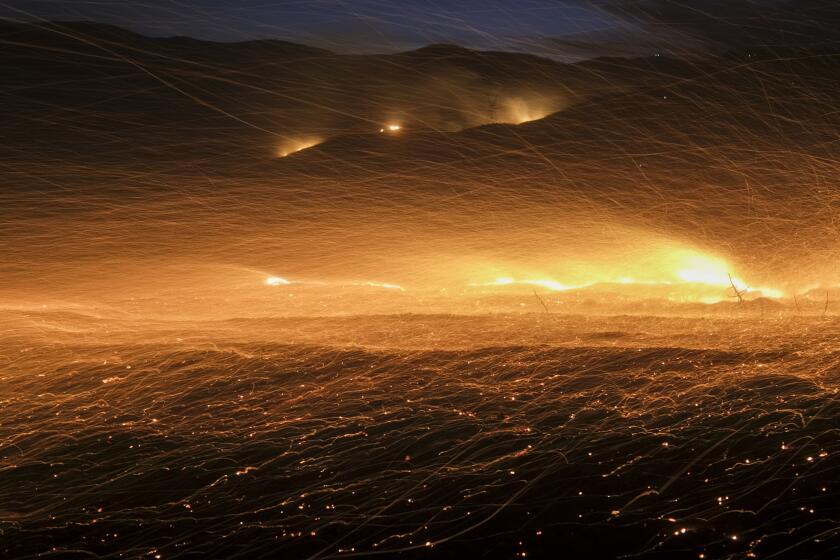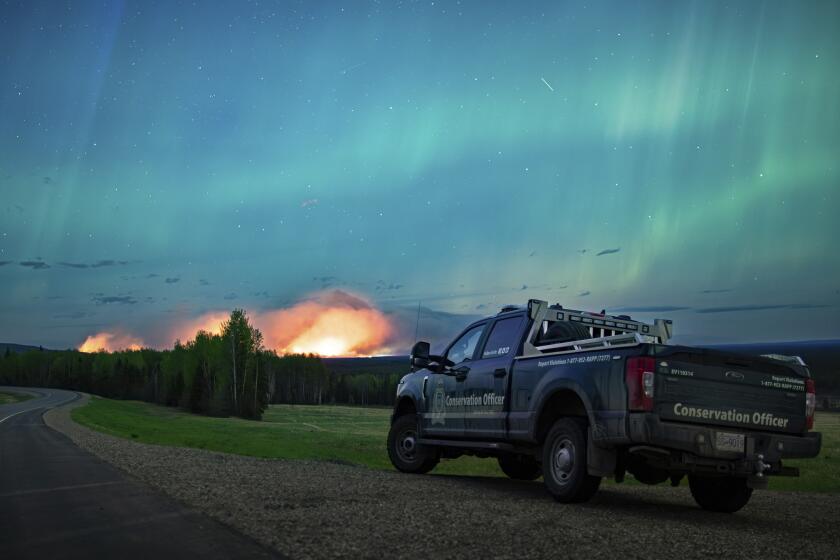After a Long, Anxious Night, Evacuees of Malibu Fire Count Blessings
The new fire rose out of the eucalyptus on the far side of the canyon Tuesday morning, so orange and tall it grew, until it was--the sun. The people on the north side of Latigo Canyon Road let out a deep breath, or lay down their binoculars, or otherwise rejoiced quietly, shyly even.
The new day was here. So were their homes. So were they.
Ten hours earlier--after the Super Scoopers disappeared for the last time into the darkening eastern sky, after the American Red Cross began brewing its coffee and after 2,500 firefighters dug in for an all-night fight--human dramas had begun to unfold throughout Malibu as everyone waited for the eerie flames of a fire to rip through the dark of night.
At a seaside shelter, clusters of evacuees huddled together, seeking safe harbor from the flaming chaos. Fear supplanted any hope of sleep for the 30 or so refugees as fire came so close to the back door that they could feel the heat through a window.
“I think we’re going to have to leave this place,” said Atiya Sheikh, 24, when the nocturnal shelter at the Michael Landon Recreation Center appeared to be under siege, firefighters fending off the perilously close flames that sent smoke and red embers into the sky like some mad fireworks display.
Sheikh and her mother--British tourists--were witnesses and potential victims of their first Southern California-style emergency. Like scores of Malibu residents, they feared that valued possessions--in this case a rented recreational vehicle, passports, pictures and cash--would be consumed by fire.
“Maybe it’s one of the natural features of America--catastrophe,” said Sheikh, 53.
Adele Porter was a reluctant midnight evacuee, sent to the Malibu High School gym despite her misgivings about leaving her longtime home.
The 78-year-old Malibu resident told deputies she wanted to sleep in her own bed. But the uniformed officers insisted that she leave, saying that even they feared the oncoming fire.
An exhausted Porter settled into a cot surrounded by about 40 other displaced residents and sipped hot chocolate with her granddaughter.
“I’ve been in Malibu since 1956 and we haven’t lost a house yet,” she said. “I’m a veteran of Malibu disasters. I’ve been through this so many times.”
Along the winding Latigo Canyon Road, a 40-year resident was on hand, wearing a flowered garden hat and protective goggles. And there were the firefighters from Pasadena who hadn’t seen a fire-and-ocean view like this for some time.
They also hadn’t seen a resident like Mary Prismon, who, after four decades and three “close encounter fires,” predicted just what this blaze would do.
“Happens every time: It burns over the top and goes slow down that side,” Prismon informed them as night fell. “Then it just speeds right up through here.”
After removing the stereo, television and other important items from one house, Pepperdine University students Jake Gores and Dave Reed relaxed at Gores’ canyon apartment and took in a front-row show of the fast-approaching flames. If they had to evacuate, they said, they would evacuate. No huge deal.
“Our neighbors are all going crazy,” said Reed, 19. “They all have fire hoses and stuff. They were filling up garbage cans with water. They were telling us to fill up our bathtub.”
As the night wore on, fire engines raced from one hot spot to another, turning Pacific Coast Highway into an iridescent raceway of flashing lights and blaring sirens. Firefighters not only battled the blaze, they battled sleeplessness as they toiled to contain firestorms on steep and treacherous terrain.
“The first 24 hours aren’t so bad,” said David Pryor, a firefighter from Orange County who took a midnight break at City Hall before returning for the night shift. “After that is when it gets tough.”
Pryor said the nighttime fire poses its own special hazards. “It’s easier to see the fire, but it’s harder to see where you’re going,” he said.
One group of inmate firefighters near Pepperdine University learned what happens when the terrain fades into a dark background.
At one point in their shift, a rabbit scurried from the bushes and toward the men from Norco state prison. Their commander, Capt. Norman Howell, ordered them to keep clear of the hare--not out of compassion but for self-preservation.
“A rabbit will get you killed,” Howell told his men. “They [catch fire], run around and catch all the brush on fire.”
Less than a mile west, at Malibu City Hall, officials tracked the massive firefighting effort, which brought more 2,500 firefighters from cities across the region to protect the mountainous enclaves.
Huge floodlights transformed the gray municipal building into a command center of bright and hectic commotion. Off in the shadows, dozens of fire engines roared through the parking lot, while exhausted firefighters gathered in groups, waiting for their next assignment. In the predawn darkness, the ghostly figures of the haggard firefighters lined up outside a tent for their morning rations--portions of scrambled eggs, sausage and hash browns.
The firefighters gripped their plates as chilly winds rushed through the camp, shaking the tent and threatening to scatter the food. The scrambled eggs were cold and smelled like smoke. “Just like everybody,” a firefighter said.
But there was some good news: 10% of the fire had been contained.
“I call it luck, miracles, fire prevention, strategy and some incredible planning,” said Sarah Maurice, a city spokeswoman.
It was 6 a.m. and the first swath of light crept across the horizon.
More to Read
Start your day right
Sign up for Essential California for news, features and recommendations from the L.A. Times and beyond in your inbox six days a week.
You may occasionally receive promotional content from the Los Angeles Times.






